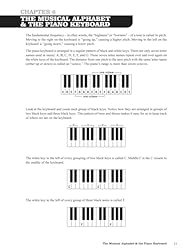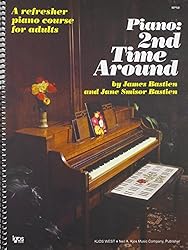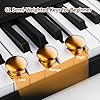Table of Contents
Introduction to Learning Piano by Ear
Learning to play the piano by ear is an incredibly rewarding skill that opens up a new dimension of musical expression and independence. This approach allows musicians to play songs without the need for written music, relying instead on their aural skills to interpret and reproduce the sounds they hear. Understanding the basics of melody, harmony, and rhythm are crucial in mastering this skill. This introduction will explore the foundational steps necessary for anyone aspiring to learn piano by ear, emphasizing the importance of regular practice, attentive listening, and progressive training techniques.
Developing Your Listening Skills for Piano
Learning piano by ear requires a keen sense of listening and the ability to distinguish between different pitches, rhythms, and harmonies. Here are some essential steps to develop your listening skills:
Learn How to Play Piano / Keyboard BY EAR! Without Reading Music - Everything Shown in Keyboard View: Chords - Scales - Arpeggios Etc.
$20.49 (as of October 26, 2025 01:14 GMT -07:00 - More infoProduct prices and availability are accurate as of the date/time indicated and are subject to change. Any price and availability information displayed on [relevant Amazon Site(s), as applicable] at the time of purchase will apply to the purchase of this product.)Piano Book for Adult Beginners: Teach Yourself How to Play Famous Piano Songs, Read Music, Theory & Technique (Book & Streaming Video Lessons)
13% OffPiano by Ear: Learn to Play by Ear, Improvise, and Accompany Songs in Simple Steps (Faber Edition)
How to Play Blues Piano by Ear - Book/Online Audio
Active Listening
Active listening involves fully concentrating, understanding, and responding to music. Sit down with a piece of piano music, close your eyes, and focus on each note and chord progression. Try to identify different parts of the music, such as the melody, harmony, bass line, and rhythmic patterns. This practice enhances your ability to break down and understand complex musical pieces.
Ear Training Exercises
Engage in regular ear training exercises to sharpen your auditory skills. Practice identifying intervals, chords, and scales by ear. Use online tools, apps, or software that offer interactive ear training exercises. Start with simple intervals like major and minor seconds and gradually move to more complex ones.
Play by Imitation
Listen to a simple piano piece and try to replicate it on your instrument. Start with short phrases and gradually attempt to play longer segments. Pay close attention to the dynamics, articulation, and phrasing of the music. Imitation helps internalize musical structures and enhances muscle memory.
Sing What You Play
Singing the notes and melodies you play strengthens the connection between your ear and fingers. Try to sing the notes of a scale or a simple melody before playing them on the piano. This process will improve your pitch recognition and your ability to reproduce what you hear.
The Piano Proficiency Exam Review Book
$9.99 (as of October 25, 2025 23:33 GMT -07:00 - More infoProduct prices and availability are accurate as of the date/time indicated and are subject to change. Any price and availability information displayed on [relevant Amazon Site(s), as applicable] at the time of purchase will apply to the purchase of this product.)Ready for Theory Level 2 Piano Review Book (Ready for Theory Piano Review Books)
$10.95 (as of October 25, 2025 23:26 GMT -07:00 - More infoProduct prices and availability are accurate as of the date/time indicated and are subject to change. Any price and availability information displayed on [relevant Amazon Site(s), as applicable] at the time of purchase will apply to the purchase of this product.)Piano 2nd Time Around : A Refresher Piano Course for Adults
P71 Digital Piano Review and Guide
$0.00 (as of October 25, 2025 10:11 GMT -07:00 - More infoProduct prices and availability are accurate as of the date/time indicated and are subject to change. Any price and availability information displayed on [relevant Amazon Site(s), as applicable] at the time of purchase will apply to the purchase of this product.)Transcribe Music
Transcribing involves listening to a piece of music and writing it down by ear. Start with simple melodies and gradually tackle more complex compositions. Paying attention to details such as rhythm, melody, and harmony is crucial. This practice deepens your understanding of musical structure and notation.
Use a Slow-Down Tool
Various tools and software allow you to slow down music without changing its pitch. Use these tools to listen to fast or intricate pieces at a slower tempo, making it easier to distinguish each note and passage. Over time, try to play along with the slowed-down version and progressively increase the speed as you become more comfortable.
Record and Review
Record yourself playing by ear and listen to the playback. Compare it with the original piece to identify any discrepancies in pitch, rhythm, and dynamics. Self-evaluation through recording helps pinpoint areas that need improvement and tracks your progress over time.
Analyze Music
Listen to various genres and styles of piano music and analyze their components. Working on identifying the key signature, tempo, chord progressions, and form will heighten your musical awareness. Analyzing different pieces broadens your understanding and adaptability when learning new music by ear.
Join a Music Group
Playing with other musicians or joining a music group can significantly enhance your listening skills. Interaction with other players requires keen listening to stay in sync and blend harmoniously. Ensembles, duets, or bands provide practical experience and dynamic learning opportunities.
Recognizing and Playing Chords by Ear
Learning to recognize and play chords by ear is an essential skill for any pianist looking to improve their ability to play music without relying on sheet music. Here are some modern techniques and tips to help you master this skill:
Before you can recognize chords by ear, it’s crucial to understand their basic structures. Chords are combinations of specific notes played simultaneously:
- Major chords: Consist of a root note, a major third, and a perfect fifth. For example, a C Major chord includes C, E, and G.
- Minor chords: Consist of a root note, a minor third, and a perfect fifth. For example, a C Minor chord includes C, Eb, and G.
- Seventh chords: Add a seventh interval to either major or minor chords, such as C7 (C, E, G, Bb) or Cm7 (C, Eb, G, Bb).
Start with simple songs that use basic chord progressions. Popular and folk music often features repetitive and recognizable chords. Play along and try to identify each chord by ear. Repetition will help you internalize these patterns.
Numerous apps are designed to help musicians recognize chords by ear. These apps play a chord and ask you to identify it. Over time, this practice will sharpen your ear for different sounds and chord qualities. Some popular choices include:
- Perfect Ear
- Toned Ear
- Functional Ear Trainer
When you hear a chord, try to break it down note by note. Listen for the bass note first, as it often defines the chord’s root. Next, identify the other notes in the chord. This methodical approach can make the process less overwhelming.
Use songs and chords you already know as references. If you hear a chord in a new song, compare it to those familiar chords. This contextual learning helps in recognizing similar-sounding chords in different pieces of music.
A great way to internalize chords is to sing each note in the chord. This practice enhances your aural skills and helps you remember the sound of each note’s role within the chord. Training your voice as well as your ear connects pitches to their respective keys on the piano.
Once you become comfortable recognizing chords, try to play songs by ear. Start by figuring out the melody, then add chords. Trust your instincts and adjust as needed. The more you practice, the better you’ll get at playing complete songs by ear.
Recording yourself while experimenting with chords can provide valuable feedback. Listen to the playback to identify mistakes and understand what needs improvement. This self-assessment helps in developing a more accurate ear.
By systematically applying these techniques, you can enhance your ability to recognize and play chords by ear, making you a more versatile and intuitive pianist.
Tips for Memorizing Songs Without Sheet Music
Break Down the Song into Sections
Start by dividing the song into manageable sections such as verses, choruses, and bridges. Focus on memorizing one section at a time before moving on to the next. This approach can make a complex song seem less daunting and easier to internalize.
Use Repetition and Practice Regularly
Repetition is crucial for memorization. Practice each section multiple times until you can play it smoothly from memory. Regular, consistent practice sessions are more effective than cramming all at once.
Listen Actively and Often
Active listening involves focusing closely on the song to understand its structure, melody, and rhythm. Play the song repeatedly in different contexts—while driving, exercising, or relaxing—to help embed it in your memory.
Sing or Hum the Melody
Before trying to play the song, sing or hum the melody. This technique helps reinforce your understanding of the song’s structure and makes it easier to recall the notes when you play.
Use Visualization Techniques
Visualize yourself playing the song without actually being at the piano. Picture the keys, finger movements, and even the sound. This mental practice can significantly enhance your ability to memorize pieces.
Understand the Song’s Structure
Analyze the song’s structure, including chords, key changes, and patterns. Understanding how the song is built can make it easier to remember. Knowing the theory behind the music provides a framework that aids memorization.
Record Your Practice Sessions
Recording your practice sessions allows you to review your performance and identify areas that need improvement. Listening to these recordings can also help reinforce your memory by providing a clear reference of how the song should sound.
Engage Multiple Senses
Engage as many senses as possible. Play the song slowly and pay attention to how it feels, sounds, and even looks on the keyboard. The more senses involved, the stronger the memory connections.
Practice Hands Separately
Initially, practice the left and right hand parts separately. This approach allows you to focus on perfecting each hand before combining them, making the process of memorization more manageable.
Incorporate Rhythmic and Melodic Patterns
Identify any recurring rhythmic and melodic patterns in the song. These patterns serve as memory anchors and can make it easier to recall the piece as a whole.
Stay Relaxed and Patient
Keeping a relaxed and patient mindset can make the memorization process less stressful. Understand that memorizing a song takes time and persistence. Avoid rushing and allow yourself to progress at a comfortable pace.
Practicing Melodies and Harmonies by Ear
Practicing melodies by ear involves breaking down the process into manageable steps to enhance your aural skills. Here are the latest methodologies to practice melodies by ear:
Understanding and practicing harmonies by ear requires a slightly different approach since you’re dealing with multiple notes played simultaneously. Here’s how you can practice harmonies:
Using Technology to Enhance Ear Training
In the modern digital age, technology has revolutionized the way we approach learning musical instruments, including learning piano by ear. Here are some ways you can leverage technology to enhance your ear training skills:
There are numerous apps designed to improve your ear training abilities. These apps offer exercises on identifying intervals, chords, and scales. Some popular apps include:
Platforms such as Udemy, Coursera, and YouTube host hundreds of video tutorials that can help you develop your ear training skills. These courses are often taught by professional musicians and educators, providing structured lessons and practice opportunities. Make sure to explore:
Digital Audio Workstations (DAWs) such as Logic Pro, Ableton Live, and FL Studio allow you to analyze and deconstruct songs you’re interested in. Using these tools, you can isolate tracks, slow down music, and evaluate the structure and harmony more thoroughly. Key features include:
Sites like Teoria and Musictheory.net provide interactive exercises to improve your ear training. These websites offer:
The latest advancements in AI have led to the development of innovative tools that assist with ear training. Software like Yousician and SmartMusic harness AI to provide real-time feedback and personalized exercises. Features include:














































